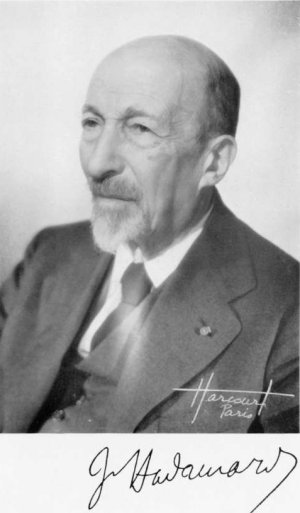- Jacques Hadamard
Infobox_Scientist
name = Jacques Hadamard
 |300px
|300px
image_width = 300px
caption = Jacques Salomon Hadamard
birth_date = birth date|1865|12|8|mf=y
birth_place =Versailles ,France
death_date = death date and age|1963|10|17|1865|12|8|mf=y
death_place =Paris ,France
nationality = French
residence =France
field =Mathematician
work_institution =University of Bordeaux Sorbonne Collège de France
alma_mater =École Normale Supérieure
doctoral_advisor = C. Émile PicardJules Tannery
doctoral_students =Maurice René Fréchet Paul Lévy Szolem Mandelbrojt André Weil Xinmou Wu
known_for = Hadamard productProof of prime number theorem
prizes =Grand Prix des Sciences Mathématiques (1892)Prix Poncelet (1898)
religion =
footnotes =Jacques Salomon Hadamard (
December 8 ,1865 –October 17 ,1963 ) was a Frenchmathematician best known for his proof of theprime number theorem in 1896.Biography
Hadamard studied at the
École Normale Supérieure under the direction ofCharles Émile Picard . After theDreyfus affair , which involved him personally (Dreyfus was his brother-in-law), Hadamard,Jewish himself in his historical identity, became politically active and became a staunch supporter of Jewish causes [ [http://press.princeton.edu/einstein/book/2dHadamard.pdf The Psychology of Invention in the Mathematical Field] ] though he professed to be an atheist in his religion. [ [http://www-groups.dcs.st-and.ac.uk/~history/Extras/Hadamard_Hermite.html Hadamard on Hermite ] ]He introduced the idea of "
well-posed problem " in the theory ofpartial differential equation s. He also gave his name to theHadamard inequality on volumes, and theHadamard matrix , on which theHadamard transform is based. TheHadamard gate inquantum computing uses this matrix.His students included Maurice Fréchet, Paul Lévy,
Szolem Mandelbrojt andAndré Weil .On creativity
In his book "Psychology of Invention in the Mathematical Field", Hadamard uses
introspection to describe mathematical thought processes. In sharp contrast to authors who identifylanguage andcognition , he describes his own mathematical thinking as largely wordless, often accompanied bymental images that represent the entire solution to a problem. He surveyed 100 of the leading physicists of the day (approximately 1900), asking them how they did their work. Many of the responses mirrored his; some reported seeing mathematical concepts as colors.Hadamard described the experiences of the mathematicians/theoretical physicists
Carl Friedrich Gauss ,Hermann von Helmholtz ,Henri Poincaré and others as viewing entire solutions with “sudden spontaneousness.” [ Hadamard, 1954, pp. 13-16.] The same has been reported in literature by many others, such as Denis Brian, [ Einstein, after years of fruitless calculations, suddenly had the solution of thegeneral theory of relativity revealed in a dream “like a giant die making an indelible impress, a huge map of the universe outlined itself in one clear vision.” See Brian, 1996, p. 159.]G. H. Hardy , [G. H. Hardy cited how the mathematicianSrinivasa Ramanujan had “moments of sudden illumination.” See Kanigel, 1992, pp. 285-286.] ,B. L. van der Waerden , [von Franz, 1992, p. 297 and 314. Cited work: B. L. van der Waerden, "Einfall und Überlegung: Drei kleine Beiträge zur Psychologie des mathematischen Denkens" (Gasel & Stuttgart, 1954).] , Harold Ruegg. [von Franz, 1992, p. 297 and 314. Cited work: Harold Ruegg, "Imagination: An Inquiry into the Sources and Conditions That Stimulate Creativity" (New York: Harper, 1954)] , Friedrich Kekulé (dreamed of benzene ring) and Tesla.Hadamard described the process as having four steps of the five-step
Graham Wallas creative process model, with the first three also having been put forth by Helmholtz: [ Hadamard, 1954, p. 56.]
*Preparation
*Incubation
*Illumination
*VerificationMarie-Louise von Franz , a colleague of the eminent psychiatristCarl Jung , noted that in these unconscious scientific discoveries the “always recurring and important factor … is the simultaneity with which the complete solution is intuitively perceived and which can be checked later by discursive reasoning.” She attributes the solution presented “as anarchetypal pattern or image.” [ von Franz, 1992, pp. 297-298.] As cited by von Franz, [von Franz, 1992 297-298 and 314.] according to Jung: “Archetypes … manifest themselves only through their ability to "organize" images and ideas, and this is always an unconscious process which cannot be detected until afterwards.” [Jung, 1981, paragraph 440, p. 231.]Writings
* Jacques Hadamard "The Psychology of Invention in the Mathematical Field" (Dover, 1954) ISBN 0-486-20107-4 ( Princeton University Press, 1945)
* Jacques Hadamard "The Mathematician's Mind: The Psychology of Invention in the Mathematical Field" (Princeton, 1996) ISBN 0-691-02931-8ee also
*
Cartan–Hadamard theorem
*Cauchy-Hadamard theorem
* Hadamard product
*Hadamard's dynamical system
*Hadamard's inequality
*Hadamard three-circle theorem
*Hadamard manifold
*Hadamard matrix
*Hadamard space
*Ostrowski-Hadamard gap theorem
*Hadamard finite part integral
*Hadamard-Rybczynski equation External links
*
*Further reading
* "Life and Work of Jacques Hadamard", Vladimir Maz'ya [http://www-groups.dcs.st-and.ac.uk/~history/Biographies/Mazya.html] & T. O. Shaposhnikova, American Mathematical Society, February 1998, hardcover, 574 pages, ISBN 0-8218-0841-9
References
* Denis Brian "Einstein: A Life" (John Wiley and Sons, 1996) ISBN 0-471-11459-6
* Jacques Hadamard "The Psychology of Invention in the Mathematical Field" (Dover, 1954) ISBN 0-486-20107-4
* C. G. Jung "The Collected Works of C. G. Jung. Volume 8. The Structure and Dynamics of the Psyche. " (Princeton, 1981) ISBN 0-691-09774-7
*Robert Kanigel "The Man Who Knew Infinity: A Life of the Genius Ramanujan " (Washington Square Press, 1992) ISBN 0-671-75061-5
* Marie-Louise von Franz, "Psyche and Matter" (Shambhala, 1992) ISBN 0-87773-902-1Notes
Persondata
NAME= Hadamard, Jacques
ALTERNATIVE NAMES=
SHORT DESCRIPTION= FrenchMathematician
DATE OF BIRTH=December 8 ,1865
PLACE OF BIRTH= Versailles, France
DATE OF DEATH=October 17 ,1963
PLACE OF DEATH=Paris ,France
Wikimedia Foundation. 2010.
